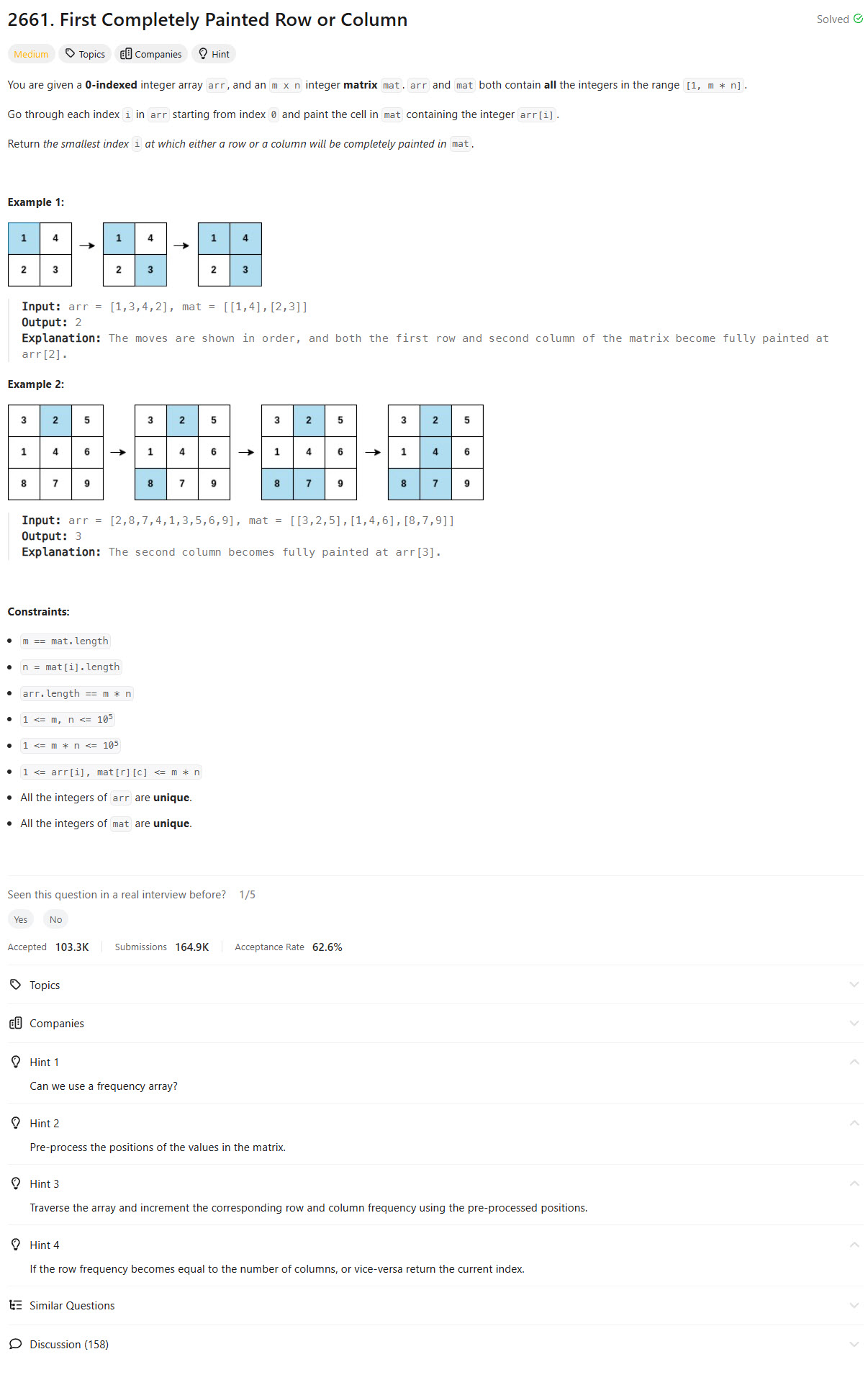Problem of The Day: First Completely Painted Row or Column
Problem Statement

Intuition
The problem requires finding the first complete row or column after processing elements in the array arr. My initial thought was to keep track of the frequency of elements in rows and columns as they appear in arr and determine the point at which any row or column becomes “complete” (all elements in that row/column are present in arr).
Approach
-
Initialization:
- Identify the number of rows (
ROWS) and columns (COLS) in the matrixmat. - Create two frequency arrays,
row_freqandcol_freq, to track how many elements have been processed for each row and column. - Use a dictionary
posto map each value inmatto its coordinates(row, col).
- Identify the number of rows (
-
Mapping Values:
- Traverse the matrix
matand populate theposdictionary with the positions of each value.
- Traverse the matrix
-
Processing Array:
- Iterate through the array
arr. - For each value in
arr, retrieve its position(row, col)using theposdictionary. - Increment the corresponding row and column frequencies in
row_freqandcol_freq. - Check if the updated frequency for the row or column equals the number of elements in that row/column:
- If so, return the current index
ias it represents the first complete row or column.
- If so, return the current index
- Iterate through the array
Complexity
-
Time Complexity:
- Preprocessing the matrix to populate
postakes \(O(ROWS \times COLS)\). - Iterating through the array
arrtakes \(O(n)\), wherenis the length ofarr. - Overall, the complexity is \(O(ROWS \times COLS + n)\).
- Preprocessing the matrix to populate
-
Space Complexity:
- Storing the
posdictionary requires \(O(ROWS \times COLS)\). - Frequency arrays
row_freqandcol_freqrequire \(O(ROWS + COLS)\). - Overall, the complexity is \(O(ROWS \times COLS)\).
- Storing the
Code
class Solution:
def firstCompleteIndex(self, arr: List[int], mat: List[List[int]]) -> int:
ROWS = len(mat)
COLS = len(mat[0])
row_freq = [0] * ROWS
col_freq = [0] * COLS
pos = defaultdict(list)
for row in range(ROWS):
for col in range(COLS):
val = mat[row][col]
pos[val] = [row, col]
for i, x in enumerate(arr):
row, col = pos[x]
row_freq[row] += 1
col_freq[col] += 1
if row_freq[row] == COLS or col_freq[col] == ROWS:
return i
Editorial
Approach 2: Brute Force Optimized with Counting
class Solution:
def firstCompleteIndex(self, arr: List[int], mat: List[List[int]]) -> int:
num_rows, num_cols = len(mat), len(mat[0])
row_count, col_count = [0] * num_rows, [0] * num_cols
num_to_pos = {}
# Create a map to store the position of each number in the matrix
for row in range(num_rows):
for col in range(num_cols):
num_to_pos[mat[row][col]] = [row, col]
for i in range(len(arr)):
num = arr[i]
row, col = num_to_pos[num]
# Increment the count for the corresponding row and column
row_count[row] += 1
col_count[col] += 1
# Check if the row or column is completely painted
if row_count[row] == num_cols or col_count[col] == num_rows:
return i
# This line will never be reached as per the problem statement
return -1
Approach 3: Reverse Mapping
class Solution:
def firstCompleteIndex(self, arr, mat):
# Map to store the index of each number in the arr
num_to_index = {}
for i in range(len(arr)):
num_to_index[arr[i]] = i
result = float("inf")
num_rows, num_cols = len(mat), len(mat[0])
# Check for the earliest row to be completely painted
for row in range(num_rows):
# Tracks the greatest index in this row
last_element_index = float("-inf")
for col in range(num_cols):
index_val = num_to_index[mat[row][col]]
last_element_index = max(last_element_index, index_val)
# Update result with the minimum index where this row is fully painted
result = min(result, last_element_index)
# Check for the earliest column to be completely painted
for col in range(num_cols):
last_element_index = float("-inf")
for row in range(num_rows):
index_val = num_to_index[mat[row][col]]
last_element_index = max(last_element_index, index_val)
# Update result with the minimum index where this column is fully painted
result = min(result, last_element_index)
return result